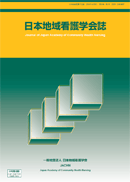Volume 18, Issue 1
Displaying 1-13 of 13 articles from this issue
- |<
- <
- 1
- >
- >|
-
Article type: Article
2015 Volume 18 Issue 1 Pages 4-11
Published: August 31, 2015
Released on J-STAGE: April 20, 2017
Download PDF (886K) -
Article type: Article
2015 Volume 18 Issue 1 Pages 12-19
Published: August 31, 2015
Released on J-STAGE: April 20, 2017
Download PDF (959K) -
Article type: Article
2015 Volume 18 Issue 1 Pages 20-27
Published: August 31, 2015
Released on J-STAGE: April 20, 2017
Download PDF (1077K) -
Article type: Article
2015 Volume 18 Issue 1 Pages 28-37
Published: August 31, 2015
Released on J-STAGE: April 20, 2017
Download PDF (1143K) -
Article type: Article
2015 Volume 18 Issue 1 Pages 38-46
Published: August 31, 2015
Released on J-STAGE: April 20, 2017
Download PDF (963K) -
Article type: Article
2015 Volume 18 Issue 1 Pages 47-55
Published: August 31, 2015
Released on J-STAGE: April 20, 2017
Download PDF (1185K) -
Article type: Article
2015 Volume 18 Issue 1 Pages 56-64
Published: August 31, 2015
Released on J-STAGE: April 20, 2017
Download PDF (1078K) -
Article type: Article
2015 Volume 18 Issue 1 Pages 65-74
Published: August 31, 2015
Released on J-STAGE: April 20, 2017
Download PDF (1196K) -
Article type: Article
2015 Volume 18 Issue 1 Pages 75-81
Published: August 31, 2015
Released on J-STAGE: April 20, 2017
Download PDF (941K) -
Article type: Article
2015 Volume 18 Issue 1 Pages 82-92
Published: August 31, 2015
Released on J-STAGE: April 20, 2017
Download PDF (1165K) -
Article type: Article
2015 Volume 18 Issue 1 Pages 93-101
Published: August 31, 2015
Released on J-STAGE: April 20, 2017
Download PDF (1193K) -
Article type: Article
2015 Volume 18 Issue 1 Pages 102-109
Published: August 31, 2015
Released on J-STAGE: April 20, 2017
Download PDF (1170K) -
Article type: Article
2015 Volume 18 Issue 1 Pages 110-117
Published: August 31, 2015
Released on J-STAGE: April 20, 2017
Download PDF (950K)
- |<
- <
- 1
- >
- >|
